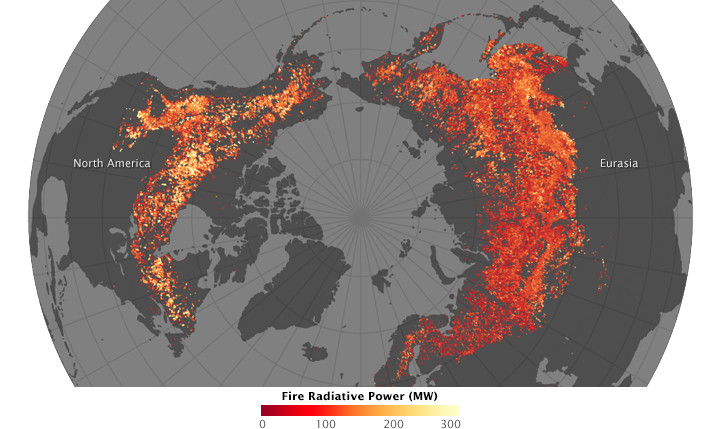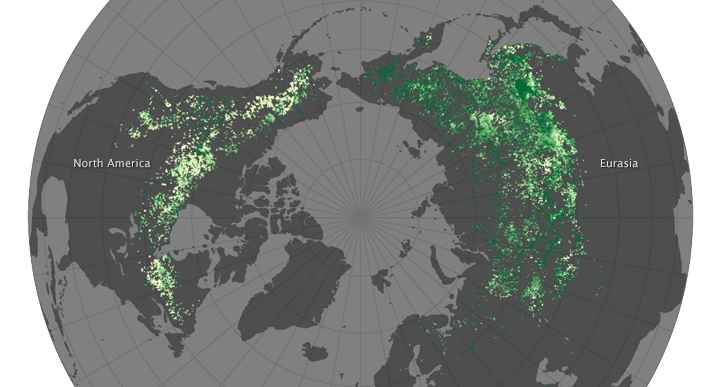



In the high latitudes of the northern hemisphere, much of the landscape is covered by boreal forest, or taiga. These regions are incredibly rich in organic matter (carbon), and they are also prone to intense fires that can send smoke thousands of miles downwind. These evergreen forests make up one-third of Earth’s forested area, so their fires play an important role in regional and global climate patterns. That role is evolving as the world warms.
In new research published in Nature Geoscience on February 2, 2015, scientists described how fires burn differently in the northern tier of North America compared to the northern tier of Eurasia despite very similar conditions. Combining ten years of satellite data with computer models and ground-based observations, the researchers found that boreal forest fires in North America spread faster, burn hotter and longer, send smoke higher into the atmosphere, and kill more trees than fires in Eurasia. This satellite view aligns with previous ground-based observations that North American forests are more prone to crown fires—which burn from the floor to the tree tops—while Eurasia has more surface fires.
The researchers, led by Brendan Rogers of Woods Hole Research Center, also found that fires increased springtime albedo in North American boreal forests more than in Eurasia. As fires burn through the tree canopy, they expose more of the snow on the landscape. The snow cover reflects more sunlight and can even have a cooling effect in the first decade. There is less albedo change in Eurasia because fires tend to burn closer to the ground and do not necessarily change the view of the forest from space. Rogers collaborated with scientists at the University of California–Irvine and at NASA’s Langley Research Center.
The maps above show the continental differences in boreal forest burning. The top map shows fire radiative power, a measure of the intensity of the fires; specifically, the energy released from fire (in megawatts). The second map shows the change in albedo, or how the land surface reflects light. Note that the maps look down on the North Pole, with North America on the left and Eurasia on the right. In both maps, the brighter colors represent the greatest changes.
Boreal forests are dominated by hardy coniferous trees that can withstand dark, cold winters and thrive during brief but wildly productive summers. With a landscape covered in snow for much of the year, these forests of spruce, pine, and larch are moist and cool and surprisingly rich in carbon. Organic matter tends to accumulate on the taiga floor because the cool conditions suppress decay. In fact, boreal environments store an estimated one-fifth to one-third of all terrestrial carbon stocks (between the trees and the soils beneath them).
With all of that fuel on the ground, the forests are prone to large fires in the summer growing season, accounting for about 10 percent of global fire and smoke emissions. A growing body of evidence suggests that such fires will become more frequent and more destructive as the planet warms and the growing season lengthens.
Having established that boreal forest fires were different on the two landmasses, Rogers and colleagues tried to figure out why. They examined “fire weather” conditions—such as humidity, temperature, and winds—on both continents and found little difference over the study period (2001 to 2013).
But the forests are different in a critical way. In North America, the dominant tree species tend to be “fire embracers.” That is, the life cycles of the forests have evolved to sustain nearly complete burns (crown fires) and to quickly re-colonize an area after a fire. North American forests tend to have more black spruce, white spruce, and jack pine—species with branches lower to the ground, thinner bark, and pine cones that open up after being burned by fire. On the other hand, Eurasian forests have more species that resist fire with thicker bark, moister needles, and fewer low-hanging branches.
“These adaptations to surviving in fire-prone environments have resulted in very different fire regimes between the continents,” Rogers said. “Given the scale, this may represent the single greatest influence of individual species on continental patterns of carbon and energy flux, except for humans.”
In the new study, Rogers and colleagues found that burn severity was 37 percent lower in the boreal forests of Eurasia than in North America, and there was 65 percent less change in albedo. Destruction of trees and of overall vegetation was 35 to 40 percent lower from fires in Eurasia. The researchers deduced that fires in North America have an overall cooling impact in the first decade because of increased spring albedo, those in Eurasia may be warming or closer to climate-neutral.
The next step is figuring out how these continental forest differences contribute to and interact with other environmental changes in a warming world. One thing Rogers and colleagues know is that current models tend to lump boreal forests and their climate inputs together, though the real world is more complex.
“While North American boreal fires are thought to have a cooling effect because of large increases in spring albedo, little is known about the climate forcing from Eurasian fires,” Rogers and colleagues wrote in their paper. “Global fire models using generic plant functional types do not account for species-driven differences and may therefore miss important feedbacks. It is therefore of central importance to the scientific, modeling, mitigation and management communities to understand the spatial distribution of fire types, what drives them, and how they interact with climate.”
NASA Earth Observatory maps by Joshua Stevens, based on data from Brendan Rogers, Woods Hole Research Center. Caption by Mike Carlowicz. This research was funded by NASA and the National Science Foundation.